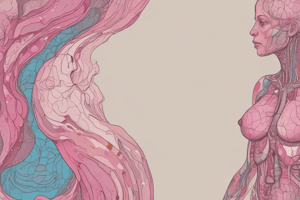Podcast
Questions and Answers
What clinical sign indicates involvement of Cooper's ligaments in breast disorders?
What clinical sign indicates involvement of Cooper's ligaments in breast disorders?
Dimpling
In which condition are the superficial lymphatics involved, leading to a peau d'orange appearance?
In which condition are the superficial lymphatics involved, leading to a peau d'orange appearance?
Inflammatory breast cancer
What BIRADS score indicates incomplete imaging and what is its recommended action?
What BIRADS score indicates incomplete imaging and what is its recommended action?
BIRADS 0; Additional imaging is required
When using the dial clock method for breast examination, what age group is it primarily recommended for?
When using the dial clock method for breast examination, what age group is it primarily recommended for?
For a BIRADS score of 3, what follow-up is recommended and what is the associated risk of cancer?
For a BIRADS score of 3, what follow-up is recommended and what is the associated risk of cancer?
What is the significance of BRCA1 and BRCA2 gene mutations in breast cancer?
What is the significance of BRCA1 and BRCA2 gene mutations in breast cancer?
List two imaging indications for using MRI in the context of breast cancer.
List two imaging indications for using MRI in the context of breast cancer.
How does age relate to breast cancer risk according to the risk factors?
How does age relate to breast cancer risk according to the risk factors?
What is the role of Ki-67 in breast cancer assessment?
What is the role of Ki-67 in breast cancer assessment?
Identify the most common type of breast cancer and its origin.
Identify the most common type of breast cancer and its origin.
What molecular characteristics define the Luminal A subtype of breast cancer?
What molecular characteristics define the Luminal A subtype of breast cancer?
Explain the relationship between smoking and breast cancer risk.
Explain the relationship between smoking and breast cancer risk.
What is the recommended action when 21 or more blood relatives are diagnosed with breast cancer before age 55?
What is the recommended action when 21 or more blood relatives are diagnosed with breast cancer before age 55?
Flashcards
Incisional Biopsy
Incisional Biopsy
A type of biopsy where a small piece of tissue is removed from the breast using a small instrument.
Tru-cut/Core Needle Biopsy
Tru-cut/Core Needle Biopsy
A type of biopsy where a core of tissue is removed from the breast using a needle.
Early Menarche
Early Menarche
Early onset of menstruation, usually before 12 years of age.
Hormone Replacement Therapy (HRT)
Hormone Replacement Therapy (HRT)
A hormone replacement therapy used to manage menopausal symptoms.
Signup and view all the flashcards
Triple Negative Breast Cancer (TNBC)
Triple Negative Breast Cancer (TNBC)
A type of breast cancer that does not express estrogen receptors (ER), progesterone receptors (PR), or the HER2 protein.
Signup and view all the flashcards
HER2
HER2
A protein found in breast cancer cells that can help predict how aggressive the cancer is.
Signup and view all the flashcards
Estrogen Receptor (ER)
Estrogen Receptor (ER)
A protein that binds to estrogen and plays a role in breast cancer development.
Signup and view all the flashcards
Progesterone Receptor (PR)
Progesterone Receptor (PR)
A protein that binds to progesterone and plays a role in breast cancer development.
Signup and view all the flashcards
Dimpling of the breast
Dimpling of the breast
A pattern of small indentations on the skin of the breast caused by the shortening and thickening of the ligaments of Cooper, often a sign of invasive breast cancer.
Signup and view all the flashcards
Retraction of Breast Tissue
Retraction of Breast Tissue
A pulling inward of the skin of the breast, usually caused by the contraction of the lactiferous ducts due to tumor infiltration. This can also indicate cancer.
Signup and view all the flashcards
Peau d'Orange (PDO)
Peau d'Orange (PDO)
A thickened, dimpled, or orange peel-like texture on the breast, commonly caused by edema in the lymphatic vessels beneath the skin.
Signup and view all the flashcards
What is BIRADS?
What is BIRADS?
A system used to categorize breast imaging findings based on their likelihood of being cancerous. It uses categories 0-6 to describe the probability of malignancy.
Signup and view all the flashcards
What is the 'Dial Clock' method?
What is the 'Dial Clock' method?
A technique used to assess the breast by systematically palpating the area, dividing it into imaginary quadrants and performing circular motions in a clock-wise pattern.
Signup and view all the flashcardsStudy Notes
Breast Cancer
- Most common type: Invasive ductal carcinoma
- Origin: Terminal duct lobular unit (Tolu)
- Quadrants affected: Upper outer, lower inner, upper inner, lower outer
Genetic Mutations
-
Breast cancer:
- Sporadic (90%): no known mutation
- Familial (10%):
- BRCA1
- BRCA2
- TP53
- PTEN
-
Indications for BRCA testing:
- Patient with BRCA1/2 gene mutation in a blood relative
- History of ovarian, fallopian tube, or peritoneal cancer
- 21 or more blood relatives diagnosed with breast cancer
- 50 or more blood relatives diagnosed with breast cancer at 550 years
- Triple negative breast cancer at 500 years
- Male breast cancer
Immunohistochemistry (IHC)
- ER: Measured with Alcian blue (steroid receptor)
- HER 2 neu: Cell membrane stains brown (membraneous receptor)
- Ki 67: Proliferation index marker
Molecular Subtypes
- Based on gene expression profiling: Luminal A, Luminal B, Basal like (TNBC), HER2 enriched, etc.
Studying That Suits You
Use AI to generate personalized quizzes and flashcards to suit your learning preferences.




